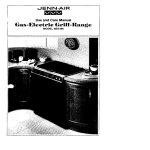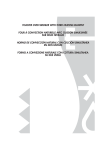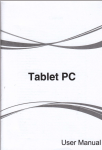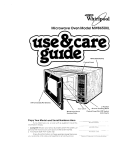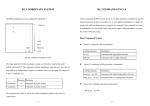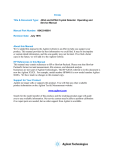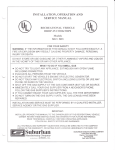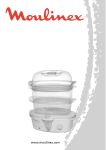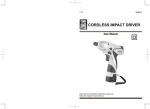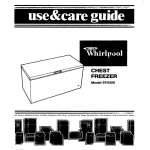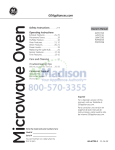Download Jenn-Air W122 User's Manual
Transcript
t.I E N N-AI R Use and Care Manual Self-Cleanlng Radiant Bake and Convection Oven MODELS W122, W225 ForMicrowaveOvenUse& Care,referto CatalogNo.MU145UA SAFETY PRECAUTIONS Read before operating your oven All appliances--regardless of the manufacturer--have the potential through improper or careless use to create safety problems. Therefore the following safety precautions should be observed: 1, Be sure your appliance is properly installed and grounded by a qualified technician. 2, Never room. use your appliance for warming or heating the 3, Children should not be left alone or unattended in area where appliance is in use. They should never be allowed to sit or stand on any part of the appliance. 4. Wear proper apparel. Loose-fitting or hanging garments should never be worn while using the appliance. 5, Do not repair or replace any part of the appliance unless specifically recommended in this manual. All other servicing should be referred to an authorized Jenn-Air Service Contractor. 6, Flammable materials should not be stored in an oven. 7. Do not use water on grease fires. Smother fire or flame or use dry chemical or foam-type extinguisher. 8. Use only dry potholders. Moist or damp potholders on hot surfaces may result in burns from steam. Do not let potholder touch hot heating elements. Do not use a towel or other bulky cloth. 9. Use care when opening door. Let hot air or steam escape before removing or replacing food. 10. Do not heat unopened food containers. Build-up of pressure may cause container to burst and result in injury. 11. Keep oven vent ducts unobstructed. 12. Always place oven racks in desired location while oven is cool. If rack must be moved while oven is hot, do not let potholder contact hot heating element in oven. 13. Do not clean door gasket. The door gasket is essential for a good seal. Care should be taken not to rub, damage, or move the gasket. 14. Do not use oven cleaners. No commercial oven cleaner or oven liner protective coating of any kind should be used in or around any part of the oven. 15. Clean only parts listed in this manual. 16. Before self-cleaning other utensils. the oven, remove broiler pan and 17. Listen for fan. A fan noise should be heard during the broil and cleaning cycles. If not, call a serviceman before self-cleaning again. 18. DO NOT TOUCH HEATING ELEMENTS OR INTERIOR SURFACES OF OVEN. Heating elements may be hot even though they are dark in color. Interior surfaces of any oven become hot enough to cause burns. During and after use, do not touch, or let clothing or other flammable materials contact heating elements or interior surfaces of oven until they have had sufficient time to cool. Other surfaces of the appliance may become hot enough to cause burns--among these surfaces are: oven vent openings and surfaces near these openings, oven doors, windows of oven doors. About JennoAir Your Oven Your Jenn-Air oven combines the best of two cooking methods, convection and radiant bake (conventional) baking or roasting, in a self-cleaning oven. The benefits of convection cooking, used by major restaurants and chefs all over the world for years, are yours with a simple turn of a dial. The Jenn-Air convection oven is actually a conventional oven that circulates heated air within the oven. As both bake and broil heating elements cycle on and off with the thermostat, a fan keeps the heated air circulating around the food. The constantly recirculating heated air in the convection oven strips away the layer of cooler air that surrounds food. Consequently, many foods cook more quickly. Distributed heat makes multiple rack cooking possible. Convection roasted meats retain their natural flavor and juiciness with less shrinkage than radiant heat roasting. In addition to the many exclusive benefits of convection cooking, your Jenn-Air oven is also a fine full-featured "bake and broil" oven. 4 You can cook your "old favorite" recipes as you have in the past. The radiant bake oven also gives you the flexibility of preparing various foods when convection cooking may not be as beneficial, as when cooking foods in covered casseroles or clay pots. The broil element is convenient for top browning and oven broiling of foods. The time bake feature can be used with either the convection or radiant bake oven. Since this manual explains how you can obtain the best use of your oven, it is essential that you follow the instructions carefully. This will enable you to fully enjoy and properly maintain your Jenn-Air oven and will also assure you of achieving the finest cooking results with the foods you prepare.., year after year. Should you have any questions about using your Jenn-Air appliance, write to us. Be sure to provide the model number of your appliance. Consumer Services Department Jenn.Air Company 3035 Shadeland Avenue Indianapolis, IN 46226-0901 index Baking ...................... General Recommendations ................... Convection Baking ........................... Baking Charts ............................ Multiple Rack Cooking ....................... 10 11 12-13 14 Broiling ................................................................ 20-21 Cleaning ..................... 22-25 26-27 Self-Cleaning Process ..................... Other Cleaning Tips ...................... Clock Controls ............................................................. Control Panel ............................................................. Light Bulb Replacement ................................................... MEAL TEMP ........................................................... Rack Positions ............................................................. 8 6-7 26 18-19 9 Roasting ..................... 15 15 16-17 2-3 28-29 Ge.neral Recommendations ................... Radiant Bake Roasting ....................... Convection Roasting ...................... Safety Precautions ....... ................................................. Service Tips ............................................................ Oven Oven Operation Control Panel Indicator Oven lightswitch Lights: Bake Lock Clean W121, W225 Selector knob "_. Door lock lever Clock controls minute timer Door lock switch Indicator Oven light switch Temperature Door knob Lights: Bake Lock Clean Meal Temp Indicator Light, Knob 7J Oven Light Switch • The light automatically comes on whenever the oven door is opened. When door is closed, push in switch to turn oven light on or off. Light cannot be turned on during the self-cleaning process. Door Lock Switch • Used in conjunction process. Selector with DOOR LOCK LEVER to lock door for the self-cleaning lla, ob • This knob controls the oven operation. To operate then turn TEMPERATURE knob to desired setting. The settings the oven, turn to desired setting, are: OFF The oven will not operate when knob is on this setting. on this position when oven is not in use. BAKE Use for radiant TIME BAKE Use with clock controls for automatically starting and stopping oven when baking or roasting in the radiant bake oven. CONMECT Use for convection TIME CONMECT Use with clock controls for automatically starting and stopping oven when baking or roasting in the convection oven. BROIL Use for top browning or oven broiling CLEAN Use for self-cleaning process. Temperature bake (conventional) baking baking Keep knob or roasting. or roasting. of foods. (See pages 20-21) (See pages 22-25). Knob • Use to set oven temperature. Be sure the indicator line is in line with the exact temperature desired. This knob is used with all oven operation settings noted on the SELECTOR knob. Bake Indicator Light • Indicates when oven is turned to an operating position other than the CLEAN setting. Light will glow until the desired temperature is reached. It will cycle on and off as this temperature is maintained during cooking. Lock Indicator Light • Will glow after the oven door has been locked and after the oven temperature 550 °. Door will lock automatically and cannot be opened until oven temperature below 550° Clean Indicator • Indicates Meal Light when all controls will remain is over drops on during have been properly the entire cleaning set for the self-cleaning process. Light process. Temp • Indicates when internal temperature of food is reached when MEAL TEMP probe is used. Light will glow and buzzer will signal when temperature is reached. (See pages 18-19) Model W141 only. Clock Controls and Minute • Features time of day, MINUTE matically. (See page 8) Door Lock controls to start and stop oven auto- Lever • Use in conjunction For model Timer TIMER, and clock with DOOR LOCK SWITCH to lock oven for self-cleaning W225 Microwave Use and Care information, 7 refer to manual process. number MU145UA. Clock Controls W121 W225 W141 To Set Clock Push in clock or MINUTE TIMER knob and turn in either direction to correct time. Reset MINUTE TIMER to OFF position. Minute Timer This interval timer reminds you when any cooking period, up to 60 minutes, has expired. Simply turn pointer to number of minutes desired. (The MINUTE TIMER on model W121 is the smallest pointer on the clock.) Do not push knob in as this will reset the clock. At the end of the selected period, the timer will sound. Turn to OFF position to discontinue signal. Timer does not control baking. Clock-Controlled Baking To set oven to start at future time and shut off automatically: 1. Set "Start" time--Push in and turn START knob to time you want food to start cooking. 2. Set "Stop" time--Push in and turn STOP knob to time you want food to stop cooking. 3. Turn SELECTOR knob to TIME BAKE or TIME CONVECT. 4. Turn TEMPERATURE knob to desired oven temperature. To set oven to start immediately and shut off automatically: 1. Set "Stop" time--Push in and turn STOP knob to time you want food to stop cooking. 2. If the START knob is in the "in" position, turn it clockwise until it pops out. 3. Turn SELECTOR knob to TIME BAKE or TiME CONVECT. 4. Turn TEMPERATURE I knob to desired temperature. to OFF Dosition. baking, turn SELECTOR NOTE: knobs After clock-controlled 8 and TEMPERATURE JI Oven Operation, Baking or Roasting 1. Locate oven racks on proper 2. Turn TEMPERATURE rack positions. knob to desired temperature. 3. Turn SELECTOR knob to BAKE or CONVECT setting. When the BAKE INDICATOR LIGHT cycles off, the oven is preheated to the selected temperature. Place the food in the oven. The BAKE INDICATOR LIGHT will cycle on and off throughout the baking process. Preheat only when necessary. Refer to baking and roasting sections as to when preheating is recommended. 4. After baking, turn both TEMPERATURE Rack and SELECTOR knobs to OFF position. Positions The rack positions noted are generally recommended for the best browning results and most efficient cooking times. Refer to charts in the baking and roasting sections for recommendations for specific foods. See page 14 for suggestions and guidelines for multiple rack cooking. Use Rack Position #1 for: Roasting large cuts of meat and large poultry, Use lhlck Position #2 for: Roasting small cuts of meat, large casseroles, tube, bundt or layer pans). frozen pies. loaves of bread, cakes (in either Use ltaick Position #3 for: Most baked goods on cookie sheet or jelly roll pan, frozen convenience Use Rack Position Most broiling. #4 for: Use Rack Position #5 Three rack cooking. for: Multiple Rack Cooking: Two racks, use #1 and 3. Three racks, use #1.3 I NOTE: Three racks provided with models 9 and 5. W141 & W225 only. foods. Baking General Baking Recommendations • When cooking foods for the first time in your new oven, use recipe cooking times and temperatures as a guide. • Use tested recipes from reliable sources. • Preheat the oven only when necessary. For baked foods that rise and for richer browning, a preheated oven is better. Casseroles can be started in a cold oven. Preheating takes from 6 to 8 minutes; place food in oven after BAKE INDICATOR LIGHT cycles off. • Arrange oven racks before turning on oven. Follow suggested rack positions on page 9 and in the various baking charts. • Allow about 1 to 1-1/2 inches of space between the oven side walls and utensils to allow proper air circulation. • When baking foods in more than one utensil, place them on opposite corners of the rack. Stagger utensils when baking on two racks so that one utensil does not shield another. (See above photo.) • To conserve energy, avoid frequent or prolonged door openings. At the end of cooking, turn oven off before removing food. • Always test for doneness (fingertip, toothpick, sides pulling away from pan). Do not rely on time or brownness as only indicators. • Use good quality baking utensils and the size recommended in the recipe. • Dull, dark, enameled or glass utensils will generally produce a brown, crisp crust. Shiny metal utensils produce a light, golden crust. • Frozen pies in shiny aluminum pans should be baked on a cookie sheet on rack 1 or be removed to a dull or glass pan. For multiple rack cooking use cookie sheets and bake on rack positions #1, 3 and 5. 10 Convection Baking Recommendations • As a general rule, when using recipes or prepared mixes developed for a radiant bake oven, set the oven temperature 25 ° F lower than the recipe recommended temperature. Times will be similar to or a few minutes less than recipe recommended times. The chart on page 12 compares times and temperatures of many baked foods. Use this as a reference. • For better browning, large utensils such as cookie sheets, jelly roll pans, or rectangular baking pans should be placed lengthwise, front to back, on the rack. This centers the food in front of the convection fan for better air circulation which gives better overall browning. (See above photo.) • Cookie sheets should be without sides and made of shiny aluminum. The best size to use for cookie sheets and jelly roll pans is 15 1/2 x 12-inches (overall size, including handles). Cookbook... Cooking with "Complete Jenn-Air" This cookbook by Jenn-Air features outstanding recipes and cooking tips you'll enjoy using with your new Jenn-Air grill and all the grill and cooktop accessories. It also contains a big section on oven baking with instructions for both convection and conventional baking of each recipe. A great way to learn about the flexibility and flavor your Jenn-Air grill-range and oven offers! Over 400 recipes with hundreds of food and "How to do it" photos. Deluxe hardcover edition, 192 pages. Model A905 11 IB;d;J._ Pan Rack* Clnalq Convection Temp. (°F) Convection Bake Radiant Temp. (°F) Radiant Bake Preheated*** Time** Preheated Time** Product and Type CAKE _.._!Z___ Yellow - 2 layers White - 2 layers Chocolate - 2 layers Bundt 9" 9" 9" tube 2 or 2 or 2 or 1 or 3 3 3 2 325 ° 325 ° 325° 325 ° 30-35 22-30 30-35 40-45 350 ° 350 ° 350 ° 350 ° 30-35 25-30 30-35 35-45 Angel Food Pound Cake tube loaf 1 or 2 2 350° 300° 28-30 40-50 375 ° 325 ° 30-40 40-50 Snacking Cake Cupcakes 8x8" 2 3 350° 325° 25-30 15-20 375 ° 350° 30-35 15-20 Sheet Cake PIES Two Crust Fruit, fresh Fruit, frozen One Crust Custard, fresh Custard, frozen Pie Shell 15x10" 3 325° 20-25 350 ° 20-25 9" 9" 2 1 375o-400 ° 375o-400 ° 35-45 45-55 400o-425 ° 400o-425 ° 35-55 45-80 9" 9" 9" 3 1 2 325 ° 350 ° 4000-425 ° 45-50 50 10-15 350 ° 375 ° [ 4250-450 ° 35-40 60-65 8-12 3 3 325°-350 ° 3250-350 ° 8-12 8-12 350°-375° i 3500-375 ° 3 2 3250-350 ° 325 ° 8-12 30-40 3500-375 ° 8-12 350 ° E 30-40 | loaf 1 or 2 3 350 ° 375 ° 25-30 10-15 375° 3750-400 ° loaf 2 325 ° 60-75 350° 60-75 9x9" 8x8" 2 2 3 3 3 325 ° 3750-400 ° 375 ° 375°-400 ° 375 ° 40 15-30 10-15 10-20 15-25 350° 400o-450 ° 400° 4000-425 ° 400° 40 15-30 10-20 10-20 15-25 I COOKIES I Chocolate Chip Peanut Butter Sugar Brownies BREADS, YEAST Loaf Roils BREADS, QUICK Loaf, Nut, Fruit Gingerbread Cornbread Cornbread Muffins Biscuits Muffins 8x8" * For Multiple Rack Baking, see page 14. ** The times given are based on specific brands of mixes or recipes tested. Actual times will depend on the ones you bake. *** The CONVECT temperature is 25°F lower than recommended on package mix or recipe. 12 8-12 8-12 30-40 |/ 15-20 / Convection Baking Frozen Convenience • Preheating of Foods the oven is not necessary. • Follow package recommendations for oven temperature, foil covering and use of cookie sheets. Baking times will be similar. See chart below for some exceptions and examples. • Center foods in the oven. If more than one food item is being baked, or if foods are being baked on multiple racks, stagger foods for proper air circulation. • Most foods are baked on rack position #3. • For multiple rack baking, use racks #1, 3, 5. However, pizzas should placed on cookie sheets and baked on rack positions #2, 3, and 4. ilere are a few examples Donuts, glazed I 3 Fsh, batter fr ed i 3 French fries i 3 Pizza I 3 of times and 300 0 5 I I I 20 15 17 Turkey, slices with gravy (TV dinner) 13 temperatures: I 425° I 25-30 450° 15-20 1 ! 6 425 o I ! 15-17 I 425° 450° 425 o be Convection Cooking on Multiple Racks For best results, bake foods on one rack at a time as described in this manual. However, very good results can be obtained when baking quantities of foods on multiple racks. Quantity cooking provides both time and energy savings. The convection oven is suggested for most multiple rack cooking, expecially three rack cooking, because the circulating heated air results in more even browning than radiant. For two rack cooking, the radiant bake oven provides very good baking results especially when pans can be staggered, such as with layer cakes. Many foods can be prepared on three racks at the same time. These are just a few examples: cookies, cakes (layer or sheet cakes), cupcakes, rolls, biscuits, muffins, pies, frozen convenience foods, pizzas, appetizers, and snack foods. To obtain the best results in multiple rack cooking, follow these suggestions: • Use temperature and times in this manual as a guide for best results. • For two rack baking, rack positions #1 and 3 are best for most baked products but positions #2 and 4 also provide acceptable results. • For three rack baking use position page 13). #1, 3 and 5. One exception is pizza (see • Since foods on positions #1 and 5 will usually be done before foods on position #3, additional cooking time will be needed for browning foods on the middle rack. An additional 30 to 60 seconds are needed for thin foods such as cookies. For foods such as biscuits, rolls, or muffins, allow 1 to 2 more minutes. Frozen pies and pizzas, which should be baked on a cookie sheet, need about 2 to 4 more minutes. • Stagger small utensils, such as layer cake pans, in the oven. • Jelly roll pans and cookie sheets should be placed lengthwise, in front of the fan for more even browning. • Oven meals are recommended #1 and 3 or #1 and 4. NOTE: Three racks provided for energy conservation. with models 14 front to back, Use rack positions W141 & W225 only. Roasting General • Preheating Roasting Recommendations is not necessary. • For open pan roasting, place meat or poultry on the slotted portion of the twopiece pan included with the oven. Do not add water to the pan. Use open pan roasting for tender cuts of meat. Less tender cuts of meat need to be cooked by moist heat in a covered utensil. • For best results, a meat thermometer is the most accurate guide to degree of doneness. See page 19 for directions on use of the MEAL TEMP feature as well as suggestions for placing a thermometer probe in meat and poultry. The suggestions for probe placement are also applicable to meat thermometers used with ovens without the MEAL TEMP feature. • Place roast fat side up to allow self basting of meat during roasting. • Since meats continue to cook after being removed from the oven, remove roast from oven when it reaches an internal temperature about 5 degrees below the temperature desired. • For less loss of juices and easier carving, allow about 15 minutes "standing time" after removing meat from oven. • For best results in roasting poultry, thaw completely. poultry, partially thawed poultry will cook unevenly. Radiant Bake Roasting Due to the structure of Recommendations • If preferred, tender cuts of meat can be roasted in the radiant bake oven by following the general recommendations given above. However, meats will roast more quickly in the convection oven. • Radiant bake is best for less tender cuts of meat that require a longer, moist heat method of cooking. Follow your recipe for times and temperatures for covered meats. • Cooking bags, Dutch ovens, covered cooked in the radiant bake oven. roasting • Use meat roasting charts in standard cookbooks temperatures for roasting on radiant bake. 15 pans and utensils for recommended are best times and Convection Roasting Recommendations • Tender cuts of meat and poultry can be quickly roasted to a rich golden brown in the convection oven. Follow general recommendations for roasting. • Refer to convection meat roasting chart for recommended cooking temperature and time. The chart can serve as a guide to help plan meal serving time. • Minutes per pound will vary according to the size, shape, quality, and initial temperature of meat as well as the electrical voltage in your area. Times are based on refrigerator cold meat. • A large cut of meat will usually require fewer minutes per pound to roast than a smaller cut of meat. • Do not use a roasting pan with high sides; use pan provided with oven. • Do not cover meat. Allow the circulating in the juices. hot air to surround the meat and seal • Since the breast meat on a large turkey cooks more quickly than the thigh area, place a "foil cap" over the breast area after desired brownness is reached to prevent overbrowning. (See above photo.) • A stuffed turkey will require an extra 30-60 minutes depending on size. Dressing should reach an internal temperature of 165 ° . Convection Roasting: Meats may be roasted frozen to finish. factory results. Frozen to Finish Follow these guidelines for the most satis- • Use temperatures for roasting fresh meats as recommended by most cookbooks. Generally, most meats and turkey are roasted at 325 ° F. For best results do not use temperatures below 300 ° F. • Use times for roasting fresh meats as given in your favorite cookbooks as approximate guides for roasting frozen meats. Roasting times will vary due to factors such as coldness of meat, size, quality, or cut. In general, roasting times for frozen to finish in the convection oven will be approximately the same as fresh to finish in a radiant bake oven. • The guidelines given for roasting fresh meats in the convection oven also apply to roasting frozen meats. • Insert meat thermometer mid-way during the cooking process. 16 Convection Roasting (Thawed Convection Oven Temperature (not preheated) °F Approximate Weight (pounds) Variety and Cut of Meat Meats Only) Internal Temperature of Meat--End of RoasUngTime °F Approximate Roasting Time (minutes per pound) BEEF Rib Roast (cutside down) 4 to 8 _ 325° Rib Eye Roast 4to 6 325° Loin Tenderloin Roast Round Eye Round Roast 2 to 3 4 to 5 400° 325° Top Sirloin Roast 3 to 6 325° , Round Tip Roast 4 to 6 325° I Leg (Fresh Ham) 10 to 16 Ham, Half (Fully cooked) Ham, Half (Cook- 5 to 7 5 to 7 before-eating) Arm Picnic Shoulder LAMB Shoulder Roast, Boneless 325° I 325° 2750 i ] 325° 5 to 8 I 3½ to 5 J , 140° 160° 140° 160° (rare) (medium) (rare) (medium) 20-25 25-30 20-25 25-30 140" 140" 160° 140° 160° 140° (rare) (rare) (medium) (rare) (medium) (rare) 15-20 20-25 25-30 20-25 25-30 20-25 160° (medium) 25-30 170° 20-30 140° 160° 20-30 30-40 140° 20-25 I I 325° = Leg, Whole 5 to 7 325° Leg, Shank Half 3 to 4 325° Leg, Sirloin Half 3 to 4 325° I 160° 170° 'I 160° 170° 160° 170° 160° (medium) (well) (medium) (well) (medium) (well) (medium) 30-35 35-40 25-30 20-35 25-30 30-35 30-35 170° (well) 35-40 VEAL Rib Roast Shoulder, Boneless Leg, Half, Boneless 3 to 5 4 to 6 3 to 5 i 325° 32°5 325° POULTRY Turkey, unstuffed Turkey, unstuffed Turkey, Whole, Bonless Turkey, Breast Chicken, Fryer ,Chicken, Roaster Capon, unstuffed Cornish Game Hen Duck 170° ' 170° 170° 35-40 35-40 35-40 i ' 16to 20 20 to 4 to 3 to 21/2to 4 to 5 to 24 6 8 3½ 6 8 325= 325° 325° 325° 375° _ , 1 to 11h 4 to 6 17 180=-185° 375° 180°-185° _ 170°-175° 180° 185° 185° 180°-185° 375° 350° 180O'185° 185° ' 11-13 _ " 9-11 25-35 25-35 18-22 15-20 15-20 i 35-45 15-20 Meal Temp -Modew141 The MEAL TEMP feature enables you to cook meats and other foods without the chore of watching a thermometer. Upon reaching selected internal temperature, a signal will sound to tell you the food is done and is ready to be removed from oven. To Use Meal Temp Feature 1. Insert the skewer-like probe into the food item. For meats, the probe tip should be located in the center of the thickest part of the meat and not in fat or touching a bone. 2. Place the food in the oven using the rack position suggested on page 9. 3. Insert the probe plug into the receptacle located behind the metal cover plate on the right inside oven wall. Be certain to insert plug !nto the receptacle all the way. 4. Set the MEAL TEMP knob to the desired internal temperature 5. Turn TEMPERATURE of food. knob to desired oven temperature. 6. Turn SELECTOR knob to BAKE or CONVECT. To use MEAL TEMP feature with TIME BAKE or TIME CONVECT, follow directions below. 7. When the selected internal temperature of the meat has been reached, the MEAL TEMP light on the control panel will glow, the signal will sound, and the oven will cycle off. To stop buzzer, turn pointer to a higher internal temperature setting or unplug cable. Internal temperature of food can be determined at any time during cooking by turning dial down until the buzzer sounds. 8. Once the selected internal temperature is reached, REMOVE FOOD IMMEDIATELY TO PREVENT OVERCOOKING. First, unplug the probe from the oven before removing food. Hold plug with potholder. 9. Turn TEMPERATURE and SELECTOR knobs to OFF position. 10. IMPORTANT: MEAL TEMP probe must be unplugged and removed from oven when it is not being used in a cooking procedure. Be sure metal cover is over receptable when MEAL TEMP feature is not being used. To Use Meal Temp Time Convect 1. Turn SELECTOR Feature with Time Bake or knob to TIME BAKE or TIME CONVECT. 2. Set desired "Start" time. Push in and turn START knob to time you wish food to start cooking. 3. Set "Stop" time well in advance of projected time food should be done since the MEAL TEMP feature will automatically cycle the oven off once the desired internal temperature has been reached. NOTE: Since food continues to cook if left in the oven, it is suggested that the clock controls be used primarily to start the oven when no one is in the kitchen to manually turn on the oven. However, provisions should be made to have the food removed as soon as the MEAL TEMP signal has sounded. 18 Hints on Sucessful Use the Meal Temp Feature of • The probe should be located in the center of the thickest part of a roast. Plan the placement of the probe tip by laying it on the outside of the meat, marking with finger where edge of meat comes on the probe. Insert probe into thickest part of muscle up to the marking held by finger. • Tip of probe should not touch fat, bone or gristle. • For turkeys and large poultry products, insert probe into the thickest part of the inner thigh. Because of variables in cooking poultry, such as size and shape, use the thermometer as a guide to the degree of doneness but also use conventional methods, squeezing or wiggling drumstick, to test for doneness. • Because of the excellent insulation of the oven, the retained heat continues to cook the meat after the signal has sounded and the oven has cycled off. For this reason, it is important to remove the meat from the oven as soon as the signal sounds. • Meats continue to cook after being removed from the oven. As a suggestion, set the internal temperature 5 degrees below the desired final degree of doneness. Allow the "standing time" before carving (15 to 20 minutes) to finish cooking the food. • Use the roasting chart on page 17 as a guide to the length of cooking time to help plan meal serving time for meats roasted in the convection oven. • Use the handle of the probe for inserting or removing. Do not pull on the cable. Use a potholder to remove since probe becomes hot. • For frozen roasts, insert probe after 11/2to 2 hours. • MEAL TEMP feature can be used to register internal foods, such as meat loaf. • To clean cooled probe, wipe with a soapy dishcloth. in water. 19 temperature of other Do not submerge probe Broiling The broil element provides flexibility for broiling foods. If you have a Jenn-Air grill, we recommend you use the grill for most of your broiling. There are some types of foods that do require use of the oven broil element. These include foods such as stuffed lobsters, meringue pies, or other foods which require top browning. ,_:-._-.- To Broil 1. Place oven rack on the rack position suggested in the chart. Distance from broiling element depends on foods being prepared. Rack position #4 (second from the top) is usually recommended unless otherwise stated. 2. Turn SELECTQR knob to BRQIL setting. 3. Turn TEMPERATURE knob to 550 ° F. 4. Place food in oven on roasting pan provided with oven after top broil element is red. Preheating takes a few minutes, or until element glows a bright cherry red. 5. Leave oven door open at broil stop position when broiling. Broiling Tips • Tender Cuts of meat or marinated meats are best for broiling. This includes rib and loin cuts of steak, ground beef, ham steaks, lamb chops, poultry pieces or fish. For best results, steaks should be at least 1" thick. Thinner steaks should be pan broiled. • Do not cover broiler grid with foil since this prevents fat drippings into bottom of pan. from draining • Before broiling, remove excess fat from meat and score edges of fat (do not cut into meat) to prevent meat from curling. Salt after cooking. 2O • To prevent tough • Foods that require turning should meat with tongs to avoid piercing • Cooking • The oven has a variable times can be varied surface given on fish, in the chart brush are to be used only a lower which means temperature knob. Using a lower temperature setting will on and off. This feature can be used for foods need less radiant heat. If foods lower temperature to reduce pan to a lower rack. NOTE: butter on top. be turned only once and loss of juices. broil feature by selecting melted are broiling the cooking during broiling. as a guide. that the broiling setting temperature on the TEMPERATURE cause the broil element that need to cook more too fast, the control speed Turn rather than to cycle slowly or can be set at a moving the broiler A fan should come on during the BROIL cycle. If it does not, the oven broil element will cycle on and off. If the fan does not operate, contact your authorized Jenn-Air Service Contractor for repair. BROILING FOODS CHART Position BEEF Steak (1") Rare Medium Well Hamburgers (3,&") Rare Medium Well 1st Side 2nd Side 3 4 5 3 4 5 3 4 4 2 2 3 5 8 9 3 5 5 (no turning) 3 8 2 3 1 5 5 3 5 4 5 3 4 4 4 4 PORK Bacon Chops (W') Chops (1") Ham Steak Sausage Links Sausage Patties 4 4 3 4 4 4 LAMB Chops (1") Medium Well Patties (3,_,,) Medium Well 4 4 POULTRY Breast Halves 3 7 SEAFOOD Fish fillets, Buttered (1/4") Scrod, Buttered (W') Cod (1") Lobster Tail 4 4 4 4 4 8 12 MISCELLANEOUS Hot Dogs Toast 4 9 12 2 NOTE: This chart is a suggested guide. The times may vary with food being cooked. 21 (no (no (no (no turning) turning) turning) turning) 2 1 Oven How the Cleaning Self-Cleaning Process Works When the oven knobs are set to CLEAN, the oven heats to temperatures that are higher than those used for cooking. The high temperatures cause food soil to burn off and substantially disappear. While this occurs, a device in the oven vent helps t(_consume smoke. The oven is vented through an opening on top of the control panel. How to Prepare the Self-Cleaning Oven Before Process Operating • Remove the roasting pan and any other utensils from the oven. These utensils cannot withstand the high temperatures of the cleaning process. • Clean spatters and spills from those areas which will not be cleaned during the selfcleaning process: --center front of oven and door near opening in door gasket. --porcelain oven door liner (area outside the door gasket). (See photo at right.) --chrome finished oven front. NOTE: DO NOT CLEAN the serial plate located on the oven front. To clean, use hot water and detergent, non-abrasive cleansers or soap-filled steel wool pads (rub with the brushed grain on the oven front frame to prevent scratching). Rinse thoroughly, being careful not to use an excessive amount of water that would dampen the door gasket. Soil left in these areas will be more difficult to remove after the self-cleaning process since the high heat will bake on any soil that is present. DO NOT USE COMMERCIAL OVEN CLEANERS TO CLEAN THESE AREAS. • DO NOT ATTEMPT TO CLEAN, RUB, OR APPLY WATER TO GASKET ON OVEN DOOR. The gasket is essential for a good door seal. Rubbing or cleaning will damage the gasket and may affect the seal. • Wipe up excess grease and food spillovers which have not baked on the bottom of the oven. Large accumulations of soil can cause heavy smoke or fire in the oven during the cleaning process. • Although smoke or fire in the oven is a normal occurrence and there is no safety problem, there will be excessive venting of smoke and odor. 22 • The oven racks and rack supports can be cleaned in the oven. However, the oven racks and rack supports will discolor, lose shininess, and become more difficult to slide in and out if left in the oven during the cleaning process. REMOVE RACKS AND RACK SUPPORTS FROM OVEN IF THIS DISCOLORATION WILL BE OBJECTIONABLE. As a suggestion, do not leave the racks in the oven during each self-cleaning process if they do not need to be cleaned since they will discolor to a dull silver after many cleanings. Be sure to read special tips on page 25 if oven racks are cleaned during the self-cleaning process. • Be sure metal cover plate wscovering the receptacle tor the MEAL TEMP probe. Steps to Follow for Self-Cleaning Process 1. Turn SELECTOR knob to CLEAN. 2. Turn TEMPERATURE knob fully clockwise to CLEAN until it comes to a full stop. The door cannot be locked if TEMPERATURE knob is not in the CLEAN position. 3. To set timer for desired cleaning one of the following procedures: time, use To set oven to start cleaning immediately: a. Check START dial to be certain pointer is at the same time of day as the oven clock. If not, turn until knob pops out and cannot be turned. b. Push in and turn STOP time dial 2 to 21/2hours beyond time indicated on the clock to clean an average soiled oven. If heavily soiled, set ahead 3 hours. To set oven to start cleaning at a later time: a. Push in and turn START dial to the time desired for the self-cleaning to begin. process b. Push in and turn STOP dial to 2 to 21/2hours beyond time set for start. If oven is heavily soiled, set ahead 3 hours. 4. Close oven door. 5. Depress DOOR LOCK SWITCH on control panel. Simultaneously, move DOOR LOCK LEVER to the full right position; then release DOOR LOCK SWITCH. 23 6. The oven CLEAN INDICATOR LIGHT will glow when all steps are completed ly when set for a delayed start. proper- 7. The cleaning process begins immediately unless the self-cleaning process has been set for a delayed start. When the oven temperature reaches 550°, the LOCK INDICATOR LIGHT will glow and the door cannot be opened until the temperature drops below 550° . DO NOT TRY TO UNLOCK THE DOOR WHILE LOCK INDICATOR LIGHT IS ON. The normal cleaning process takes the time selected on the clock plus about 45 minutes for the oven to cool down before the LOCK INDICATOR LIGHT goes out and the door can be opened. 8. After the LOCK INDICATOR LIGHT goes out, depress the DOOR LOCK SWITCH while simultaneously moving the DOOR LOCK LEVER to the left. The oven door can now be opened. 9. Turn the SELECTOR and TEMPERATURE door is unlocked. knobs from CLEAN to OFF after the IMPORTANT: IF THE TEMPERATURE KNOB IS TURNED TO OFF BEFORE THE DOOR IS UNLOCKED, THE DOOR WILL NOT OPEN. Forcing the lock will damag.e the lock mechanism. Return TEMPERATURE knob to CLEAN, unlock the door, then turn TEMPERATURE knob OFF. NOTE" A fan comes on whenver the SELECTOR knob is set to CLEAN. Therefore, I the fan will continue to operate at the end of the cleaning process until the SELECTOR ] knob is turned OFF. The fan will also start as soon as the controls are set for a de_ayed start of the se f-c ean ng process. To stop cleaning process before lock 1. Depress DOOR LOCK SWITCH while simultaneously to the left. 2. Turn SELECTOR and TEMPERATURE light comes on moving DOOR LOCK LEVER knobs from CLEAN to OFF. 3. Turn STOP time dial until it pops out. Pointer should be at the same time of day as the oven clock. To stop cleaning process after lock light comes on 1. Turn the STOP time dial until the knob pops out and the CLEAN INDICATOR goes out. 2. Leave the TEMPERATURE LIGHT and SELECTOR knobs in the CLEAN position. 3. Allow oven to cool until the LOCK INDICATOR LIGHT goes out. This may take up to 45 minutes, depending on how long the oven has been on. 4. After LOCK INDICATOR LIGHT goes off, depress the DOOR LOCK SWITCH while simultaneously moving the DOOR LOCK LEVER to the left. 5. Turn SELECTOR and TEMPERATURE knobs from CLEAN to OFF. NOTE: When SELECTOR knob is turned to CLEAN, a fan comes on. If this fan is not operating, the oven will go through the self-cleaning process at a reduced oven temperature and the oven will not clean effectively. If the fan does not operate, contact your Jenn-Air Authorized Service Contractor for service. 24 More Information on the Self-Cleaning Process • A slight odor may be detected, and if an oven is heavily soiled, some smoke may be visible. Some smoke and odor during the cleaning process is a normal occurrence. Since the oven is vented in the front, vapors, moisture, etc. may be seen coming from this area. • During the cleaning process, do not be alarmed if an occasional flame is visible through the oven window. This is caused by excessive food soil that was not removed before the oven was set to clean. • SINCE THE DOOR AND WINDOW OF THE OVEN WILL GET WARM DURING THE SELF-CLEANING PROCESS, AVOID CONTACT. • Some types of soil may disintegrate but leave a light film or heavier deposit of ash. The amount of ash depends on the amount of soil which was in the oven. After oven has cooled, this ash may be removed with a damp sponge. If other dark deposits remain after wiping with a sponge, the time set for the length of cleaning was not enough. Increase the cleaning time for future cleanings. The normal cleaning time is 2 to 21/2hours. More than 3 hours may be selected if necessary. • If racks have been left in oven during the cleaning process, they should be treated as follows. After the cleaning process is completed and the oven has cooled, rub lightly the underside of rack edges and the front edges of the rack supports with a coating of vegetable shortening, peanut oil or corn oil. Use a light application of oil so it does not soil the oven. As a suggestion, use fingertips to apply oil. This will make the cleaned racks slide more easily. • To remove occasional spillovers between cleanings, use a soap-filled pad or mild cleanser; rinse well. • It is better to clean the oven regularly buildup of soil in the oven. rather than waiting scouring until there is a heavy • During the cleaning process, the kitchen should be well ventilated to help eliminate normal odors associated with cleaning. • Any attempt to force the self-clean DOOR LOCK LEVER to lock or unlock without electric power applied to the door or with the TEMPERA TURE knob in any position other than CLEAN may result in damage to the door locking mechanism. • DO NOT USE COMMERCIAL CLEANING OVEN AREA. • DO NOT USE ALUMINUM OVEN CLEANERS IN OR AROUND THE SELFFOIL OR OTHER OVEN LINERS IN THE OVEN. 25 Before for Service You Call Check the following list to be sure a service call is really necessary. A quick reference of this manual, as well as reviewing additional information on items to check, may prevent an unneeded service call. If nothing on tire oven operates: • check for a blown circuit fuse or a tripped main circuit breaker. • check if oven is properly connected to electric circuit in house. If clock and/or lights operate but oven does not heat: • the SELECTOR and/or TEMPERATURE knobs may be set incorrectly. • clock controls may be set for delayed start of oven. If tire oven light does not work: • the light bulb is loose or defective. • oven light does not work during self-cleaning If oven will not go through self-cleanlng process: • controls may be improperly set. • door may not be locked. • check the "Start" and "Stop" time settings clock. If ol'en did not clean process. and the current time of day on the properly: • oven may need longer cleaning time. • excessive spills were not removed prior to self-cleaning process • one or several controls may have been turned from CLEAN to another position after self-cleaning process started. If oven door will not nnlock: • oven may not have cooled to safe temperature after self-cleaning process. • TEMPERATURE knob may have been switched from CLEAN position. • electric current coming into the oven may be off. If foods do not broil properly: • the SELECTOR and/or TEMPERATURE • check rack position. • voltage into house may be low. If baked food is burned or too brown knobs may not be set properly. on tap: • the SELECTOR knob may be in the BROIL position. • food may be positioned incorrectly in oven. • oven not preheated properly. 26 If foods • • • • • bake unevenly: the oven may be installed improperly. check the oven rack with a level. stagger utensils; do not allow utensils to touch each other or oven wall. check instructions for suggested placement of utensils on oven rack. rack or rack supports may be improperly installed. If cooking results are less tlnan expected: • the utensils being used may not be of the size or material recommended for best results. • there may not be sufficient room around sides of the pans for proper air circulation in the oven. • check instructions for preheating, rack position and oven temperature. If baking results differ from previous oven: • oven thermostat calibration may differ between old and new ovens. Follow recipe and use and care directions before calling for service since the calibration on the previous oven may have drifted to a too high or too low setting. If You Need Service • call the authorized Jenn-Air Service Contractor listed in the Yellow Pages or the dealer from whom your appliance was purchased. • your Jenn-Air Service Contractor can provide better and faster service if you can accurately describe problems and give model and serial number of the appliance. Be sure to retain proof of purchase to verify warranty status. Refer to WARRANTY for further information of owner's responsibi/ies for warranty service. NOTE: Complete service and parts literature orized Jenn-Air Parts Distributor. All specifications are available from any auth- subject to change by manufacturer 27 without notice, Before You Call for Service Check the following list to be sure a service call is really necessary. A quick reference of this manual as well as reviewing additional information on items to check, may prevent an unneeded service call. If nothing on the oven operates: • check for a blown circuit fuse or a tripped main circuit breaker. • check if oven is properly connected to electric circuit in house. If clock and/or ltghts operate but oven does not beat: • the SELECTOR and/or TEMPERATURE knobs may be set incorrectly. • clock controls may be set for delayed start of oven. If the oven llght does not work: • the light bulb is loose or defective. • oven light does not work during self-cleaning process. If oven tt411 not go through self-cl_anlng process: • controls may be improperly set. • door may not be locked. • check the "Start" and "Stop" time settings and the current time of day on the clock. If oven did not clean properly: • oven may need longer cleaning time. • excessive spills were not removed prior to self-cleaning process. • one or several controls may have been turned from CLEAN to another position after self-cleaning process started. If oven door 11411 not unlock: • oven may not have cooled to safe temperature after selfcleaning process. • TEMPERATURE knob may have been switched from CLEAN position. • electric current coming into the oven may be off. If foods do not broil properly: • the SELECTOR and/or TEMPERATURE knobs may not be set properly. • check rack position. • voltage into house may be low. 28 If baked food is burned or .too brown on top: • the SELECTOR knob may be in the BROIL position. • food may be positioned incorrectly in oven. If foods bake unevenly: • the oven may be installed improperly. • check the oven rack with a level. • stagger utensils; do not allow utensils to touch each other or oven wall. • check instructions for suggested placement of utensils on oven rack. If cooking results are less than expected: • the utensils being used may not be of the size or material recommended for best results. • there may not be sufficient room around sides of the pans for proper air circulation in the oven. • check instructions for preheating, rack position and oven temperature. If ME,_J, TEMP does not work: • check to be sure probe plug is properly inserted into oven receptacle. • probe may not be positioned in food properly. • MEAL TEMP dial may not be on internal temperature desired. If baking results differ from prel4ous oven: • oven thermostat calibration may differ between old and new ovens. Follow recipe and use and care directions before calling for service since the calibration on the previous oven may have drifted to a too high or too low setting. Ii" You Need Service • call the authorized Jenn-Air Service Contractor listed in the Yellow Pages or the dealer from whom your appliance was purchased. • your Jenn-Air Service Contractor can provide better and faster service if you can accurately describe problems and give model and serial number of the appliance. Be sure to retain proof of purchase to verify warranty status. Refer to WARRANTY for further information of owner's responsibilities for warranty service. NOTE: Complete service information, warranty service term, and parts list information are available from the Jenn-Air Company to any qualified appliance service contractor requesting it. All specifications subject to change by manufacturer without notice. 29





























